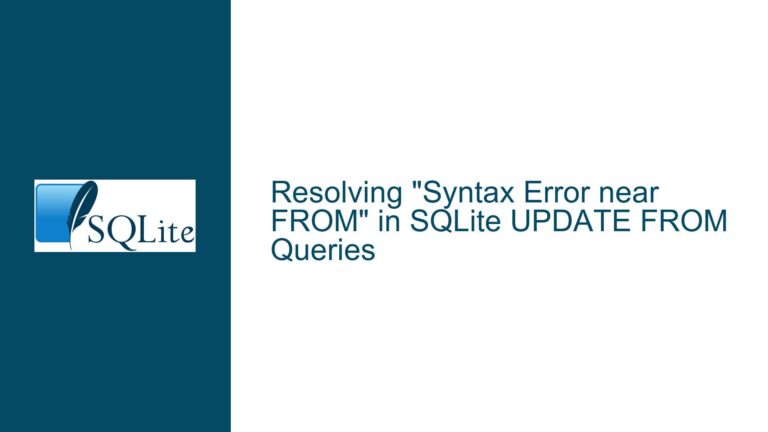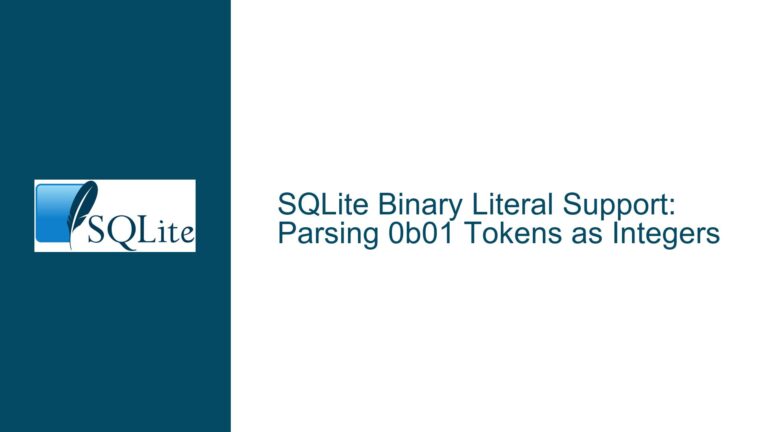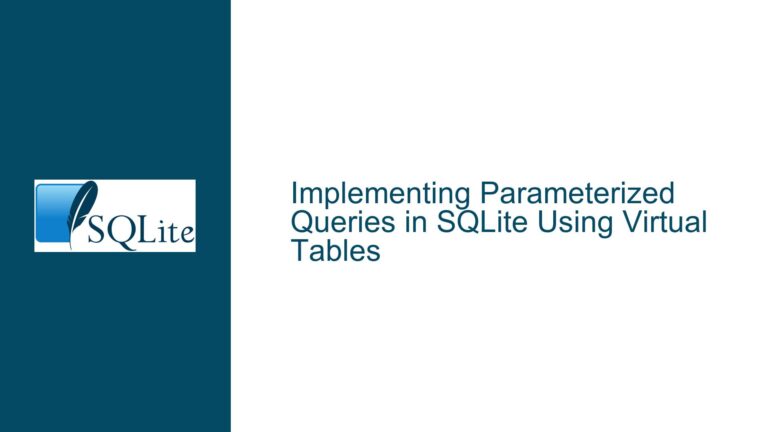Optimizing Recursive CTE Subqueries for Early Termination in SQLite
Issue Overview: Recursive CTE Evaluation and Short-Circuit Behavior
When working with recursive common table expressions (CTEs) in SQLite subqueries paired with IN or EXISTS operators, developers often encounter unexpected execution patterns. A critical optimization concern arises when attempting to terminate recursive traversal early upon finding a match – a concept colloquially termed "short-circuiting." The core challenge lies in reconciling SQLite’s declarative execution model with imperative-style early termination expectations.
This issue manifests most acutely in graph traversal scenarios (hierarchical data, dependency chains) where recursive CTEs enumerate potential matches. For example, checking whether a specific node exists in a tree hierarchy might theoretically stop recursion once found. However, SQLite’s default behavior under version 3.28.0 and earlier completes full recursion before evaluating membership checks, leading to unnecessary computational overhead in deep hierarchies.
Key technical components at play:
- Query Flattening: SQLite’s optimizer attempts to merge subqueries with outer queries where possible
- CTE Materialization: Whether intermediate CTE results persist in temporary storage
- Termination Predicate Placement: Location of match-checking logic (within CTE vs. outer query)
Possible Causes of Subquery Evaluation Completeness
Absence of Early Termination Conditions
Recursive CTEs without explicitWHERE/LIMITclauses in the outer query force full enumeration. SQLite treats the CTE as a complete result set generator before applyingINchecks.Implicit CTE Materialization
Versions prior to 3.35.0 automatically materialize CTEs under certain conditions (e.g., multiple references), creating temporary tables that prevent short-circuiting. TheMATERIALIZED/NOT MATERIALIZEDhints introduced in 3.35.0 explicitly control this behavior.Predicate Pushdown Limitations
SQLite’s query planner may fail to propagate termination conditions into the recursive CTE execution flow. Filters applied outside the CTE (likeWHERE id = ?afterSELECT * FROM found) often evaluate post-recursion.Indexing and Join Order
Missing indexes on recursive join columns (e.g.,causal_parent.causal_id) force full scans even with termination logic, undermining early exit potential.Version-Specific Query Planner Behavior
Pre-3.35 SQLite versions handle CTE flattening differently, requiring alternative syntax to achieve equivalent short-circuiting.
Troubleshooting Steps, Solutions & Fixes
Step 1: Implement Explicit Termination Conditions
Problem: Recursive CTE runs to completion despite early match potential
Solution: Inject termination checks directly into CTE iteration
Original Query:
SELECT ? IN (
WITH RECURSIVE found(id) AS (
SELECT self_hash_id FROM causal WHERE self_hash_id = ?
UNION ALL
SELECT parent_id FROM causal_parent
INNER JOIN found ON found.id = causal_id
)
SELECT * FROM found
)
Optimized Version:
SELECT EXISTS (
WITH found(id) AS NOT MATERIALIZED (
SELECT self_hash_id FROM causal WHERE self_hash_id = ?2
UNION ALL
SELECT parent_id FROM causal_parent
JOIN found ON found.id = causal_id
)
SELECT 1 FROM found WHERE id = ?1 LIMIT 1
)
Key Improvements:
EXISTSinstead ofINenables pipeline processingWHERE id = ?1inside CTE allows per-row termination checksLIMIT 1stops CTE iteration after first match
Step 2: Control CTE Materialization Behavior
Problem: Automatic materialization prevents early termination
Solution: Explicit NOT MATERIALIZED hint (3.35+) or legacy equivalent
For SQLite ≥3.35:
WITH found(id) AS NOT MATERIALIZED (...)
For SQLite <3.35 (implicit NOT MATERIALIZED):
WITH found(id) AS (
SELECT ...
UNION ALL
SELECT ...
)
-- Rely on query planner's flattening capabilities
Materialization Impact:
- Materialized: Full CTE execution, stores results in temp table
- Not Materialized: Streams results, enables predicate pushdown
Step 3: Optimize Indexing for Recursive Joins
Problem: Slow recursive joins negate short-circuit benefits
Solution: Ensure optimal index coverage
Required Indexes:
CREATE INDEX idx_causal_parent_causal_id
ON causal_parent(causal_id);
CREATE INDEX idx_causal_parent_parent_id
ON causal_parent(parent_id);
CREATE INDEX idx_causal_self_hash
ON causal(self_hash_id);
Index Usage Analysis:
- Enables nested loop joins instead of full scans
- Allows early exit when using
LIMITclauses - Reduces I/O during recursive traversal
Step 4: Handle Cyclic Graphs Gracefully
Problem: Infinite recursion in cyclic graphs
Solution: Use UNION instead of UNION ALL with visited tracking
Cycle-Safe Pattern:
WITH RECURSIVE found(id, visited) AS (
SELECT self_hash_id, json_array(self_hash_id)
FROM causal WHERE self_hash_id = ?2
UNION
SELECT parent_id, json_insert(visited, '$[#]', parent_id)
FROM causal_parent
JOIN found ON found.id = causal_id
WHERE json_valid(visited) = 1
AND json_each.value NOT IN json_array(visited)
)
SELECT 1 FROM found WHERE id = ?1 LIMIT 1
Mechanisms:
visitedJSON array tracks traversal pathUNIONdiscards duplicate entries- JSON functions validate node visitation (requires SQLite 3.38+)
Step 5: Version-Specific Workarounds
Problem: Pre-3.35.0 lacks MATERIALIZED hints
Solution: Leverage implicit NOT MATERIALIZED behavior
Legacy-Compatible Query:
SELECT EXISTS (
WITH found(id) AS (
SELECT self_hash_id FROM causal WHERE self_hash_id = ?2
UNION ALL
SELECT parent_id FROM causal_parent
JOIN found ON found.id = causal_id
WHERE found.id <> ?1 -- Early termination condition
)
SELECT 1 FROM found WHERE id = ?1 LIMIT 1
)
Version-Specific Considerations:
- Pre-3.35 automatically flattens CTEs when possible
- Termination condition must appear in both CTE and outer query
- Use
EXPLAIN QUERY PLANto verify flattening occurs
Step 6: Query Plan Analysis and Validation
Problem: Uncertain whether short-circuiting occurs
Solution: Use SQLite’s EXPLAIN functionality
Diagnostic Commands:
EXPLAIN QUERY PLAN
<your recursive query here>;
-- For bytecode analysis
EXPLAIN
<your recursive query here>;
Interpretation Guide:
- Look for
SCAN TABLE found→ Materialization occurred CORRELATED SCALAR SUBQUERY→ Possible streamingUSE TEMP B-TREE→ Materialization in progressSEARCHvsSCAN→ Index utilization
Step 7: Alternative Approaches for Complex Hierarchies
Problem: Recursive CTEs remain suboptimal
Solution: Pre-materialize hierarchies with closure tables
Closure Table Schema:
CREATE TABLE causal_closure (
ancestor INTEGER NOT NULL,
descendant INTEGER NOT NULL,
depth INTEGER NOT NULL,
PRIMARY KEY (ancestor, descendant)
);
CREATE INDEX idx_closure_descendant
ON causal_closure(descendant);
Query Rewrite:
SELECT EXISTS (
SELECT 1 FROM causal_closure
WHERE descendant = ?2 AND ancestor = ?1
LIMIT 1
)
Tradeoffs:
- Instant lookups via PK
- Storage overhead for closure pairs
- Maintenance complexity on DML
Step 8: Leverage Application-Level Caching
Problem: Repeated subquery executions negate optimizations
Solution: Cache hierarchical relationships externally
Caching Strategies:
- In-Memory Cache: Store parent/child relationships in app memory
- Materialized Views: Periodically refresh precomputed hierarchies
- Hybrid Approach: Check cache first, fallback to recursive query
Cache Population Query:
WITH RECURSIVE hierarchy AS (
SELECT self_hash_id AS root, self_hash_id AS node, 0 AS depth
FROM causal
UNION ALL
SELECT h.root, cp.parent_id, h.depth + 1
FROM hierarchy h
JOIN causal_parent cp ON h.node = cp.causal_id
)
INSERT INTO causal_closure (ancestor, descendant, depth)
SELECT root, node, depth FROM hierarchy;
Step 9: Advanced Trigger-Based Optimization
Problem: Real-time hierarchy updates require fresh data
Solution: Maintain closure table via triggers
Trigger Implementation Sketch:
CREATE TRIGGER after_causal_parent_insert
AFTER INSERT ON causal_parent
BEGIN
INSERT INTO causal_closure (ancestor, descendant, depth)
SELECT c.ancestor, NEW.parent_id, c.depth + 1
FROM causal_closure c
WHERE c.descendant = NEW.causal_id
UNION ALL
SELECT NEW.parent_id, NEW.parent_id, 0;
END;
Benefits:
- Real-time closure table updates
- Enables instant existence checks
- Shifts computational load to write operations
Step 10: Benchmarking and Profiling
Problem: Uncertain optimization effectiveness
Solution: Systematic performance measurement
Benchmarking Protocol:
Baseline Measurement:
EXPLAIN ANALYZE SELECT ? IN (...original recursive subquery...);Optimized Query Test:
EXPLAIN ANALYZE SELECT EXISTS (...optimized CTE with LIMIT...);Index Impact Analysis:
EXPLAIN QUERY PLAN <query with various index combinations>;Memory/Cache Profiling:
sqlite3 test.db '.stats mem'
Metrics to Compare:
- Values Read: Pages accessed via
EXPLAIN ANALYZE - Loop Iterations: Number of
SCANsteps - Temp Storage:
MEMORY_USEDfrom.stats - Execution Time: Wall-clock duration
This comprehensive approach addresses recursive CTE short-circuiting from multiple angles: query restructuring, index optimization, version-specific behaviors, alternative data models, and performance validation techniques. Developers should implement these solutions incrementally while monitoring actual performance characteristics in their specific use cases.






